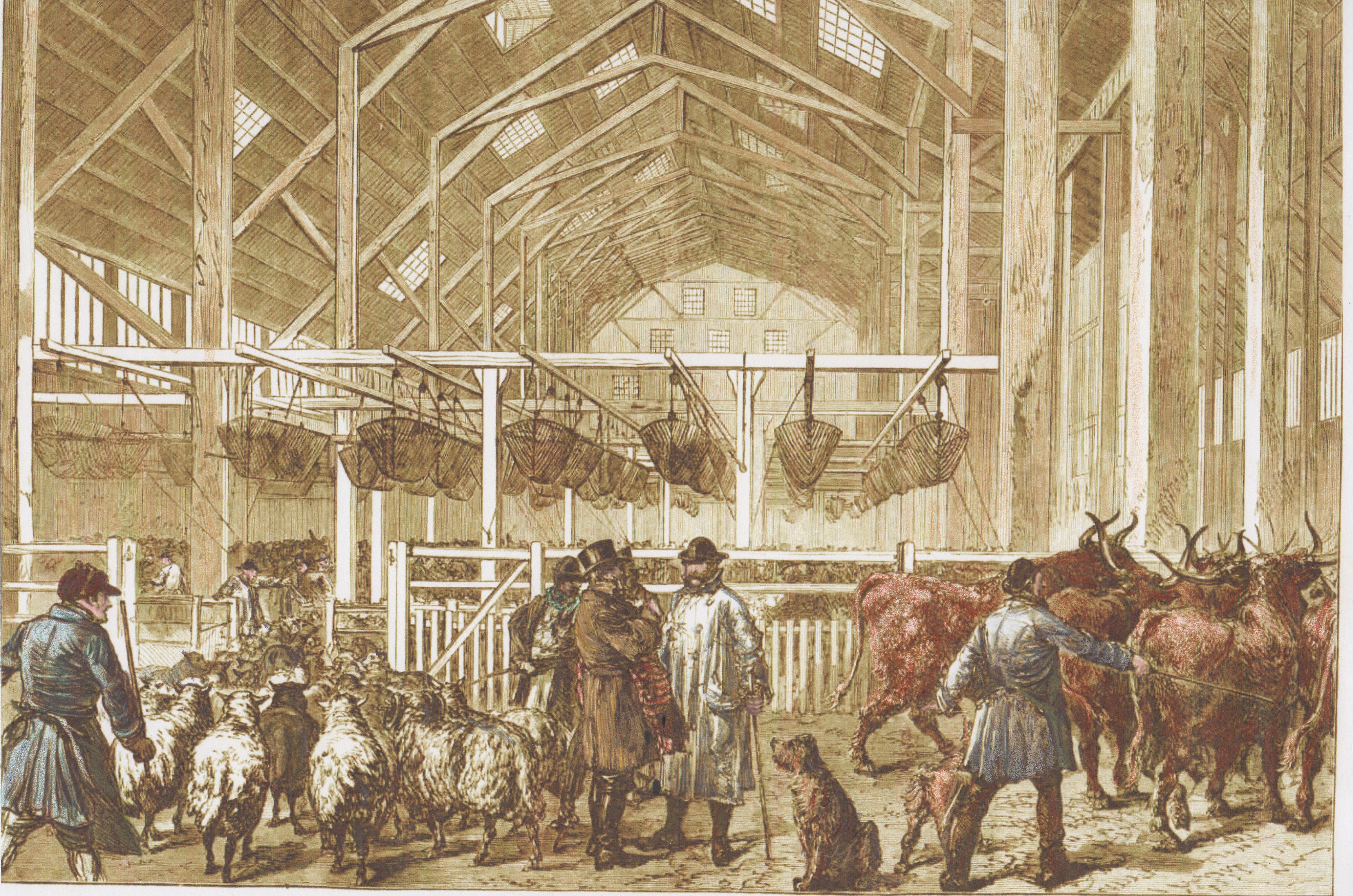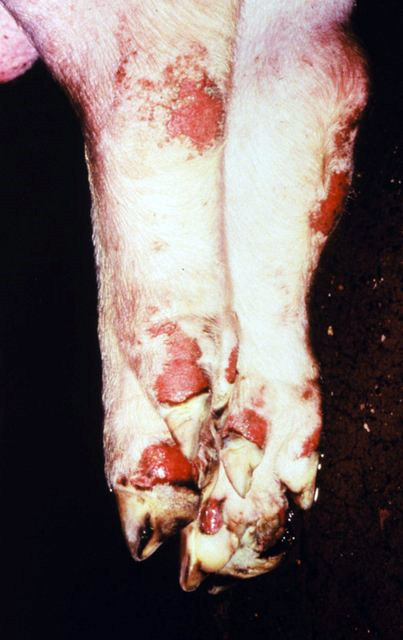|
Deptford Cattle Market
The Foreign Cattle Market in Deptford (1872–1913) was one of the two great livestock markets of London; from it came about half the capital's supply of freshly killed meat. Situated at the former royal Deptford Dockyard on a bend of the River Thames and owned by the City of London, all animals came from overseas, were landed by cattle boat, kept under quarantine conditions, and had to be slaughtered within 10 days of disembarkation. None could leave the market alive: the purpose was to stop the importation of animal diseases. Besides cattle, the market handled sheep, pigs and a few others. It could shelter 8,500 cattle and 20,000 sheep at a time, and had 70 slaughterhouses. More than a set of buildings in Deptford, it had trading links with four continents: part of what has been called the first globalisation. Cattle were brought there from the great grasslands of the world: initially, from Western Europe, Austria-Hungary and the steppes of the Russian Empire 30° to the e ... [...More Info...] [...Related Items...] OR: [Wikipedia] [Google] [Baidu] |
Islington
Islington ( ) is an inner-city area of north London, England, within the wider London Borough of Islington. It is a mainly residential district of Inner London, extending from Islington's #Islington High Street, High Street to Highbury Fields and Regent's Canal, encompassing the area around the busy High Street, Upper Street, Essex Road, and Southgate Road to the east. History Etymology The manor of Islington was named by the Saxons ''Giseldone'' (1005), then ''Gislandune'' (1062). The name means "Gīsla's hill" from the Old English personal name ''Gīsla'' and ''dun (fortification), dun'' ("hill", "Downland, down"). The name later mutated to ''Isledon'', which remained in use well into the 17th century when the modern form arose. [...More Info...] [...Related Items...] OR: [Wikipedia] [Google] [Baidu] |
Foot-and-mouth
Foot-and-mouth disease (FMD) or hoof-and-mouth disease (HMD) is an infectious and sometimes fatal viral disease that primarily affects even-toed ungulates, including domestic and wild bovids. The virus causes a high fever lasting two to six days, followed by blisters inside the mouth and near the hoof that may rupture and cause lameness. FMD has very severe implications for animal farming, since it is highly infectious and can be spread by infected animals comparatively easily through contact with contaminated farming equipment, vehicles, clothing, and feed, and by domestic and wild predators. Its containment demands considerable efforts in vaccination, strict monitoring, trade restrictions, quarantines, and the culling of both infected and healthy (uninfected) animals. Susceptible animals include cattle, water buffalo, sheep, goats, pigs, antelope, deer, and bison. It has also been known to infect hedgehogs and elephants; llamas and alpacas may develop mild symptoms, but ... [...More Info...] [...Related Items...] OR: [Wikipedia] [Google] [Baidu] |
Contagious Bovine Pleuropneumonia
Contagious may refer to: * Contagious disease Literature * Contagious (magazine), a marketing publication * ''Contagious'' (novel), a science fiction thriller novel by Scott Sigler Music Albums *''Contagious'' (Peggy Scott-Adams album), 1997 * ''Contagious'' (Sitti album), 2009 * ''Contagious'' (Third Day album), 1994 * ''Contagious'' (Y&T album), 1987 *''Contagious'', a 1987 album by The Bar-Kays *''Contagious'', a 2009 album by Tarrus Riley *''Contagious'', a 2012 album by Terron Brooks *''Contagious'', a 2003 EP by Arena Songs * "Contagious" (song), a 2001 song by The Isley Brothers *"Contagious" by Anarbor, from the album '' The Words You Don't Swallow'' *"Contagious" by Avril Lavigne, from the album '' The Best Damn Thing'' *"Contagious" by Boys Like Girls, from the album '' Love Drunk'' *"Contagious" by Collective Soul, from the album '' See What You Started by Continuing'' *"Contagious" by Ludacris featuring Jamie Foxx, from the album '' Theater of the Mind'' *"Con ... [...More Info...] [...Related Items...] OR: [Wikipedia] [Google] [Baidu] |
Charles Dickens
Charles John Huffam Dickens (; 7 February 1812 – 9 June 1870) was an English novelist, journalist, short story writer and Social criticism, social critic. He created some of literature's best-known fictional characters, and is regarded by many as the greatest novelist of the Victorian era.. His works enjoyed unprecedented popularity during his lifetime and, by the 20th century, critics and scholars had recognised him as a literary genius. His novels and short stories are widely read today. Born in Portsmouth, Dickens left school at age 12 to work in a boot-blacking factory when his father John Dickens, John was incarcerated in a debtors' prison. After three years, he returned to school before beginning his literary career as a journalist. Dickens edited a weekly journal for 20 years; wrote 15 novels, five novellas, hundreds of short stories and nonfiction articles; lectured and performed Penny reading, readings extensively; was a tireless letter writer; and campaigned vigor ... [...More Info...] [...Related Items...] OR: [Wikipedia] [Google] [Baidu] |
Germ Theory Of Disease
The germ theory of disease is the currently accepted scientific theory for many diseases. It states that microorganisms known as pathogens or "germs" can cause disease. These small organisms, which are too small to be seen without magnification, invade animals, plants, and even bacteria. Their growth and reproduction within their hosts can cause disease. "Germ" refers not just to bacteria but to any type of microorganism, such as protists or fungi, or other pathogens, including parasites, viruses, prions, or viroids. Diseases caused by pathogens are called infectious diseases. Even when a pathogen is the principal cause of a disease, environmental and hereditary factors often influence the severity of the disease, and whether a potential host individual becomes infected when exposed to the pathogen. Pathogens are disease-causing agents that can pass from one individual to another, across multiple domains of life. Basic forms of germ theory were proposed by Girolamo Fracastoro ... [...More Info...] [...Related Items...] OR: [Wikipedia] [Google] [Baidu] |
Rinderpest Tongue Lesions
Rinderpest (also cattle plague or steppe murrain) was an infectious viral disease of cattle, domestic water buffalo, and many other species of even-toed ungulates, including gaurs, buffaloes, large antelope, deer, giraffes, wildebeests, and warthogs. The disease was characterized by fever, oral erosions, diarrhea, lymphoid necrosis, and high mortality. Death rates during outbreaks were usually extremely high, approaching 100% in immunologically naïve populations. Rinderpest was mainly transmitted by direct contact and by drinking contaminated water, although it could also be transmitted by air. Rinderpest is believed to have originated in Asia, and to have spread by transport of cattle. The term ''Rinderpest'' () is a German word meaning 'cattle plague'. The rinderpest virus (RPV) is closely related to the measles and canine distemper viruses. The measles virus may have emerged from rinderpest as a zoonotic disease around 600 BC, a period that coincides with the rise of large ... [...More Info...] [...Related Items...] OR: [Wikipedia] [Google] [Baidu] |
Rinderpest
Rinderpest (also cattle plague or steppe murrain) was an infectious viral disease of cattle, domestic water buffalo, and many other species of even-toed ungulates, including gaurs, African Buffalo, buffaloes, large antelope, deer, giraffes, wildebeests, and warthogs. The disease was characterized by fever, oral erosions, diarrhea, lymphoid necrosis, and high mortality. Death rates during outbreaks were usually extremely high, approaching 100% in immunologically naïve populations. Rinderpest was mainly transmitted by direct contact and by drinking contaminated water, although it could also be transmitted by air. Rinderpest is believed to have originated in Asia, and to have spread by transport of cattle. The term ''Rinderpest'' () is a German language, German word meaning 'cattle plague'. The rinderpest virus (RPV) is closely related to the measles and canine distemper viruses. The measles virus may have emerged from rinderpest as a Zoonosis, zoonotic disease around 600 BC, a peri ... [...More Info...] [...Related Items...] OR: [Wikipedia] [Google] [Baidu] |
John Gamgee
John Gamgee (1831–1894) was a British veterinarian and inventor. He specialised in the contagious diseases of larger animals: primarily cattle and horses. Life Gamgee was born in 1831 in Florence, Grand Duchy of Tuscany, the son of Joseph Gamgee (1801–1895), a Scottish veterinarian formerly living in Essex, and his wife, Mary Ann West (1799–1873). John was a sibling of Arthur Gamgee, a biochemist, and Dr Sampson Gamgee, a surgeon and pioneer of aseptic surgery. Gamgee was educated at a number of institutions across Italy, Germany and Switzerland before graduating from the Royal Veterinary College in London in 1852. In 1855 he returned to London from the continent to lecture in veterinary medicine and surgery at Camden Hall in Camden Town. He was then living at 16 Upper Woburn Place. Following the death of John Barlow he was invited by William Dick to come to Edinburgh to lecture in animal anatomy and physiology. In 1857 he set up his own rival college: the New Edinburgh ... [...More Info...] [...Related Items...] OR: [Wikipedia] [Google] [Baidu] |
Free Trade
Free trade is a trade policy that does not restrict imports or exports. In government, free trade is predominantly advocated by political parties that hold Economic liberalism, economically liberal positions, while economic nationalist political parties generally support protectionism, the opposite of free trade. Most nations are today members of the World Trade Organization multilateral trade agreements. States can unilaterally reduce regulations and duties on imports and exports, as well as form bilateral and multilateral free trade agreements. Free trade areas between groups of countries, such as the European Economic Area and the Mercosur open markets, establish a free trade zone among members while creating a protectionist barrier between that free trade area and the rest of the world. Most governments still impose some protectionist policies that are intended to support local employment, such as applying tariffs to imports or Subsidy, subsidies to exports. Governments may ... [...More Info...] [...Related Items...] OR: [Wikipedia] [Google] [Baidu] |
Duty (tax)
In economics, a duty is a target-specific form of tax levied by a state (polity), state or other political entity. It is often associated with customs, in which context they are also known as tariffs or dues. The term is often used to describe a tax on certain items purchased abroad. A duty is levied on specific commodity, commodities, financial transactions, estate (law), estates, etc. rather than being a direct imposition on individuals or corporations such income tax, income or property taxes. Examples include customs duty, excise duty, stamp duty, inheritance tax, estate duty, and gift duty. Customs duty A customs duty or due is the indirect tax levied on the import or export of goods in international trade. In economics a duty is also a kind of consumption tax. A duty levied on goods being imported is referred to as an 'import duty', and one levied on exports an 'export duty'. Estate duty An estate duty (in the U.S. inheritance tax) is a tax levied on the Estate (law), ... [...More Info...] [...Related Items...] OR: [Wikipedia] [Google] [Baidu] |




